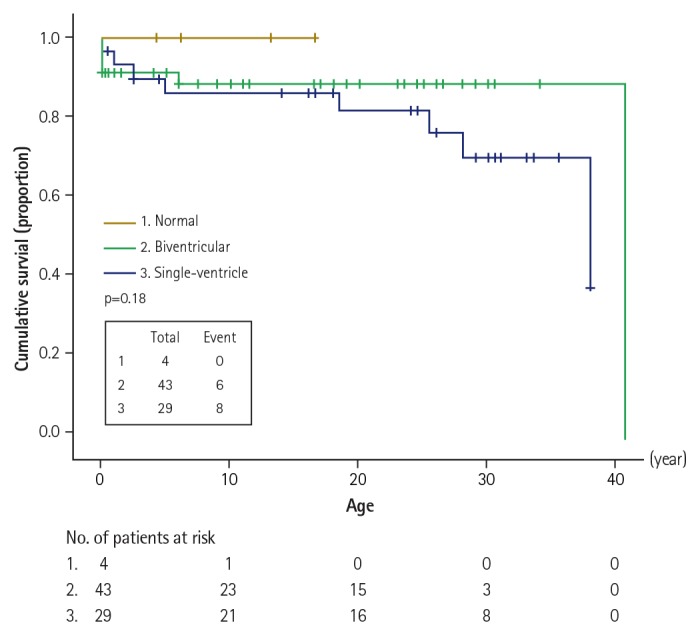Korean Circ J.
2017 Jul;47(4):501-508. 10.4070/kcj.2016.0293.
Clinical Characteristics and Independent Factors Related to Long-Term Outcomes in Patients with Left Isomerism
- Affiliations
-
- 1Department of Pediatrics, Seoul National University Children's Hospital, Seoul, Korea. eunjbaek@snu.ac.kr
- 2Department of Thoracic and Cardiovascular Surgery, Seoul National University Children's Hospital, Seoul, Korea.
- KMID: 2392888
- DOI: http://doi.org/10.4070/kcj.2016.0293
Abstract
- BACKGROUND AND OBJECTIVES
We studied the results of patient management for left isomerism (LI) and sought to determine factors that may influence survival and prognosis.
SUBJECTS AND METHODS
We reviewed the medical records of 76 patients who were compatible with LI criteria between 1982 and 2014.
RESULTS
Of the total study population, 29 patients (38.1%) had functional univentricular heart disease, 43 patients (56.5%) had cardiac anomalies suitable for biventricular hearts, and four patients (5.2%) had normal heart structure. Extracardiac anomalies were noted in 38.1% of the study population, including biliary atresia in 7.8% of all patients. Of the 25 patients who underwent Kawashima procedures, 24.0% developed pulmonary arteriovenous fistulas (PAVFs). During the median follow-up period of 11.4 years (range: 1 day to 32 years), 14 patients died. The 10-year, 20-year, and 30-year survival rates were 87%, 84%, and 76%, respectively. Preoperative dysrhythmia and uncorrected atrioventricular valve regurgitation were significantly associated with late death. There was no significant difference in the number of surgical procedures and in survival expectancy between patients in the functional single-ventricle group and in the biventricular group. However, late mortality was higher in functional single-ventricle patients after 18 years of age.
CONCLUSION
Patients with LI need to be carefully followed, not only for late cardiovascular problems such as dysrhythmia, valve regurgitation, and the development of PAVFs, but also for noncardiac systemic manifestations.
MeSH Terms
Figure
Reference
-
1. Youn JK, Lee JM, Yi NJ, et al. Pediatric split liver transplantation after Fontan procedure in left isomerism combined with biliary atresia: a case report. Pediatr Transplant. 2014; 18:E274–E279. PMID: 25263970.2. Smith A, McKay R. Atrial arrangement(situs)/Isomerism/Juxtaposition. A practical atlas of congenital heart disease. 1st ed. London: Springer-Verlag London Ltd.;2004. p. 41–52.3. Stamm C, Friehs I, Duebener LF, et al. Improving results of the modified Fontan operation in patients with heterotaxy syndrome. Ann Thorac Surg. 2002; 74:1967–1977. discussion 1978. PMID: 12643382.4. Ho SY, Seo JW, Brown NA, Cook AC, Fagg NL, Anderson RH. Morphology of the sinus node in human and mouse hearts with isomerism of the atrial appendages. Br Heart J. 1995; 74:437–442. PMID: 7488461.5. Momma K, Takao A, Shibata T. Characteristics and natural history of abnormal atrial rhythms in left isomerism. Am J Cardiol. 1990; 65:231–236. PMID: 2296892.6. Wren C, Macartney FJ, Deanfield JE. Cardiac rhythm in atrial isomerism. Am J Cardiol. 1987; 59:1156–1158. PMID: 3578058.7. Frogoudaki A, Sutton R, Gatzoulis MA. Pacing for adult patients with left atrial isomerism: efficacy and technical considerations. Europace. 2003; 5:189–193. PMID: 12633645.8. Hashmi A, Abu-Sulaiman R, McCrindle BW, Smallhorn JF, Williams WG, Freedom RM. Management and outcomes of right atrial isomerism: a 26-year experience. J Am Coll Cardiol. 1998; 31:1120–1126. PMID: 9562017.9. Uemura H, Ho SY, Devine WA, Kilpatrick LL, Anderson RH. Atrial appendages and venoatrial connections in hearts from patients with visceral heterotaxy. Ann Thorac Surg. 1995; 60:561–569. PMID: 7677481.10. Kim SJ, Bae EJ, Lee JY, Lim HG, Lee C, Lee CH. Inclusion of hepatic venous drainage in patients with pulmonary arteriovenous fistulas. Ann Thorac Surg. 2009; 87:548–553. PMID: 19161777.11. Kim SJ. Heterotaxy syndrome. Korean Circ J. 2011; 41:227–232. PMID: 21731561.12. Takeuchi K, Murakami A, Hirata Y, Kitahori K, Doi Y, Takamoto S. Surgical outcome of heterotaxy syndrome in a single institution. Asian Cardiovasc Thorac Ann. 2006; 14:489–494. PMID: 17130325.




